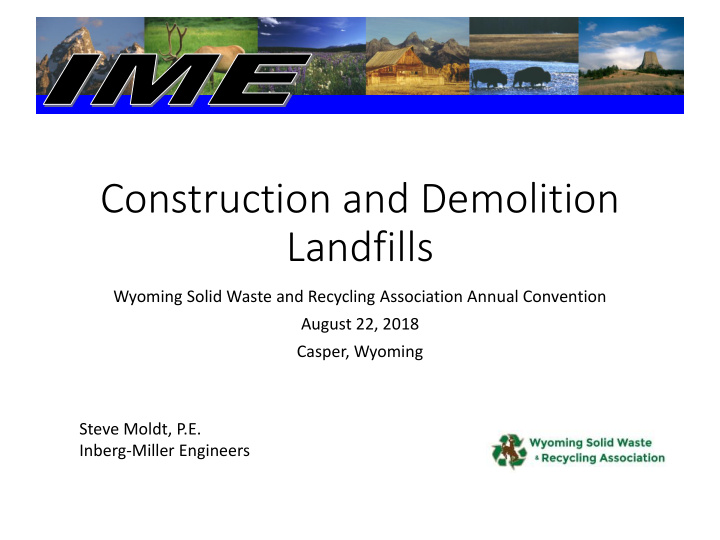



Construction and Demolition Landfills Wyoming Solid Waste and Recycling Association Annual Convention August 22, 2018 Casper, Wyoming Steve Moldt, P.E. Inberg-Miller Engineers
Chap apter 4 4 - Con onstruction/Demoli lition Lan Landfill ill Regulations, 07 07/24/15 Most of the Integrated Solid Waste Management Plans prepared in 2009 included a discussion as to what to do with Construction and Demolition Waste once you close your landfill to accepting waste and begin to transfer MSW to a regional solid waste facility. Most facilities did not want consider transferring C/D waste. However, currently there are only 3 Municipal C/D permitted landfills in the state. I know of a least 2 other facilities that are currently considering an unlined C/D Landfill.
• TYPICAL C/D RATES OF 60-40 • So if you are a 30 ton per day facility, you are generating 12 ton of C/D waste. • TWO CHOICES OF DEALING WITH C/D WASTE • Transfer with or without MSW waste to a Regional Facility. • Facility to handle transfer. • Transportation Costs. • Tipping Fee. Tip fee may be reduced if the facility has made arrangements for handling C/D waste differently from MSW waste stream. • C/D Landfill • Rules and Regulations allow for unlined facility to handle.
• SWRR Chapter 1 Section 1 (b) Construction/demolition waste definition: • Includes but is not limited to stone, clean and treated wood, concrete, asphaltic concrete, cinder blocks, brick, plaster and metal or other material specifically approve • SWRR Chapter 1 Section 1 (b) Construction/demolition landfill definition: • A solid waste management facility that accepts only inert construction waste, demolition waste, street sweepings, brush, or other material specifically approved by the Administrator. This excludes garbage, liquids, sludges, paints, solvents, putrescibles, dead animals, friable asbestos, and hazardous or toxic wastes.d by the Administrator.
Memorandum “Screening criteria for operation of unlined construction/demolition disposal facilities” – August 29, 2011, by Carl Anderson, Administrator While available data suggests that leachate from C/D landfills is not environmentally benign, it also suggests that it has less capacity to cause environmental impacts, when properly managed, than municipal solid waste.
• Siting Criteria for unlined C/D landfill: • The high groundwater level is at least 20 feet below the base of waste. • Unsaturated subsurface materials are at least 20 feet thick and composed predominately (greater than 80%) of sand, silt, and clay, or combinations thereof. • These are in addition to location standards or criteria in Chapter 1 and 4.
• Table 1. Wastes Acceptable for Disposal in an Un-lined C/D Landfill. All wastes must pass the paint filter liquid test prior to acceptance. Asphalt (hardened paving and shingles), Brick, Cabinets, Cardboard, Carpet and carpet pads, Caulking tubes (dry), Ceiling tile, Ceramics, Cinder block, Clean wood, Concrete with or without rebar/wire mesh, Asphaltic concrete, Containers (empty, clean, and rinsed), Corrugated shipping containers, Dirt (uncontaminated), Creosote treated wood (such as railroad ties and telephone poles), Drums (empty, clean, and rinsed), Drywall, Electrical fixtures, Electrical wiring, Fiberboard, Fiberglass, Flashing, Flooring tiles, Furniture, Glass, Green wastes (grass, shrubs, tree limbs, etc .), Gypsum wallboard, Hardened asphalt, Insulation (fiberglass, foam/treated cellulose/sheathing), Lumber (painted or unpainted and untreated), Masonite/slate, Metal (ferrous and non-ferrous, if not recycled), Metal studs, Masonry and plaster, Mortar, Nails, Non-friable asbestos, Paper products, Packaging foam, Paint containers (dry ), Pallets/spools/reels, Paperboard, Particleboard, Pesticide and herbicide containers if triple rinsed, Plaster, Plastic pipe, Plastic sheeting, Plumbing fixtures, Porcelain/bathroom fixtures, Pressboard/chipboard, Roofing materials/roofing felt, Sheathing, Siding (does not contain friable asbestos), Sod, Steel, Stone/rock, Street sweepings, Styrofoam, Sump waste from car wash sumps (must pass the paint filter liquids test and concentrations of metals, VOCs, and other compounds must sampled and found to be below regulatory limits), Textiles, Tile (ceiling and ceramic), Tires (may include wheels), Vinyl (doors, siding, windows, flooring), White goods/appliances (if refrigerants have been properly removed), Wire, Wood (clean, untreated, painted or unpainted), Wood pallets
• Table 2. Wastes Not Acceptable for Disposal in an Un-lined C/O Landfill. Aerosol cans containing any product, Adhesives, Automobiles, Automotive cleaners, solvents, waxes, Batteries (alkaline or rechargeable, Ni-Cd, lithium, metal hydride, etc.), Caulk, Containers with liquids, Dead animals, Driveway sealants, Drums and containers containing any waste, Epoxies, Electronic wastes, Exit signs (lighted, from building interiors), Friable asbestos, Fuel tanks, Garbage, Glues, Hazardous wastes (listed or characteristic), Industrial wastes, Lacquer thinners, Lead containing materials (lead acid batteries, lead based paint, flashing, solder, etc.), Liquids of any type or quantity, Medical/infectious wastes, Mercury containing devices (switches, bulbs, thermostats, etc.), Mercury based paints, Metallic pigments in unused paint containing: lead, arsenic, barium, cadmium, zinc, mercury, or chromium, Municipal solid waste, Oils, greases, and any petroleum contaminated, Paints, PCBs in ballasts, transformers, and capacitors, Petroleum contaminated soil, Pentachlorophenol, Pesticides, Petroleum constituents, leachable from roofing tars, Petroleum storage tanks (unless properly decommissioned and certified clean), Polyurethane, Putrescible wastes, Rechargeable and/or alkaline batteries, Resins, Roofing cement sealers, Sealers, Septage, Sludges, Smoke detectors, Solvents, Stains, Thermostats and thermometers (mercury containing), Transformers, Treated wood (e.g., pressure treated, chromated copper arsenate (green treated wood), pentachlorophenol (brown treated wood), copper naphthenate, ammoniacal copper zinc arsenate (ACZA) , ammoniacal copper quarternary compound (ACO), etc.), Used oil and/or grease filters, Varnishes
• Permitting and Operating an Unlined C/D Landfill • Site Characterization • Permitting • Monitoring Wells • Operations • Screening • Compacting • Covering • Environmental Monitoring • Closure
• Costs for Permitting and Operating an Unlined C/D Landfill-Douglas • Site Characterization $28,000 • Permitting $32,000 • Monitoring Wells $12,000 • Operations • Screening • Compacting • Covering • Environmental Monitoring $9,000/yr • Closure
Recommend
More recommend